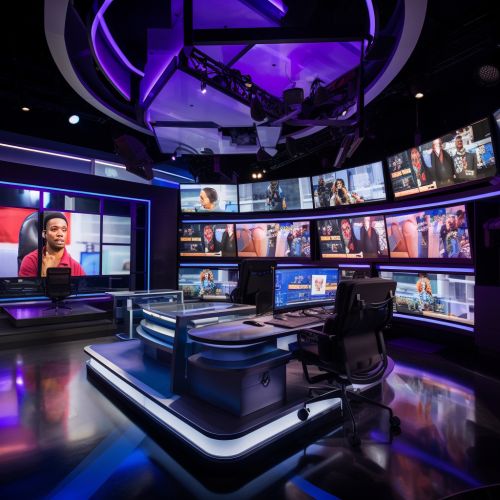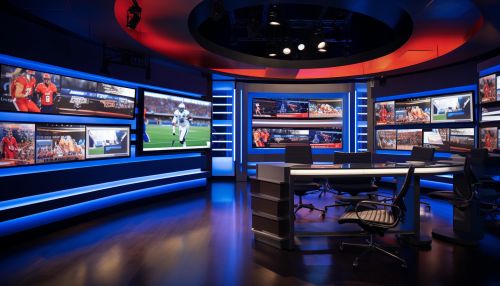Sports broadcasting
Overview
Sports broadcasting refers to the live coverage of sports events and competitions on various media platforms, including television, radio, and the internet. It involves a wide range of professionals, from commentators and analysts to camera operators and directors, all working together to deliver a comprehensive and engaging viewing experience for the audience.


History
The history of sports broadcasting dates back to the early 20th century, with the first radio broadcasts of baseball games in the United States. The first televised sports event was a college baseball game broadcast in 1939. Since then, sports broadcasting has evolved significantly, with advancements in technology allowing for high-definition broadcasts, instant replays, and interactive features.
Types of Sports Broadcasting
There are various types of sports broadcasting, each with its own unique characteristics and challenges. These include live broadcasts, delayed broadcasts, highlights shows, and sports news programs. Each type requires a different approach in terms of production and presentation.
Live Broadcasting
Live broadcasting is the most common type of sports broadcasting. It involves the real-time transmission of sports events as they happen. This type of broadcasting requires a high level of coordination and technical expertise, as there is no opportunity for post-production editing or corrections.
Delayed Broadcasting
Delayed broadcasting involves recording a sports event and broadcasting it at a later time. This is often done for events that take place in different time zones, or when there are scheduling conflicts with other broadcasts.
Highlights Shows
Highlights shows are programs that feature the best moments from a series of sports events. These shows are typically aired after the events have taken place and are popular among viewers who may not have the time to watch the entire event.
Sports News Programs
Sports news programs provide updates on recent sports events, player trades, injury reports, and other relevant information. These programs often feature interviews with athletes and coaches, as well as analysis from sports experts.
Roles in Sports Broadcasting
There are many roles involved in the production of a sports broadcast, each contributing to the overall quality and success of the broadcast.
Commentators
Sports commentators provide play-by-play descriptions of the action during a sports event. They are responsible for keeping viewers informed and engaged, often providing analysis and context to enhance the viewing experience.
Analysts
Sports analysts provide expert insight and analysis before, during, and after a sports event. They often have a deep understanding of the sport and its strategies, which they use to explain complex plays and tactics to the audience.
Camera Operators
Camera operators are responsible for capturing the action during a sports event. They must be able to follow the action closely and adjust their camera angles and zoom levels to provide the best possible view for the audience.
Directors
Directors oversee the entire production of a sports broadcast. They make decisions about camera angles, graphics, replays, and other elements of the broadcast to ensure a high-quality viewing experience.
Impact of Technology on Sports Broadcasting
Technology has had a significant impact on sports broadcasting, improving the quality of broadcasts and introducing new features that enhance the viewing experience.
High-definition Broadcasting
The introduction of high-definition broadcasting has greatly improved the visual quality of sports broadcasts. This technology allows for sharper images and more detailed views of the action, making it easier for viewers to follow the game.
Instant Replays
Instant replays have become a crucial part of sports broadcasting, allowing viewers to see key moments of a game in slow motion. This feature is particularly useful in sports where the action is fast-paced and difficult to follow in real time.
Interactive Features
Interactive features, such as on-screen graphics and statistics, have added a new dimension to sports broadcasting. These features provide viewers with additional information and context, enhancing their understanding and enjoyment of the game.
Future of Sports Broadcasting
The future of sports broadcasting is likely to be shaped by further advancements in technology and changes in viewer habits. The rise of streaming platforms and the increasing popularity of esports are two trends that are expected to have a significant impact on the industry.
Streaming Platforms
Streaming platforms are becoming increasingly popular for sports broadcasting, offering viewers more flexibility and control over what they watch. These platforms allow viewers to watch games on demand, pause and rewind live broadcasts, and access additional content such as player interviews and behind-the-scenes footage.
Esports Broadcasting
The broadcasting of esports, or competitive video gaming, is a growing trend in sports broadcasting. Esports broadcasts often feature high-quality production values, expert commentary, and interactive features, mirroring many of the elements found in traditional sports broadcasts.
